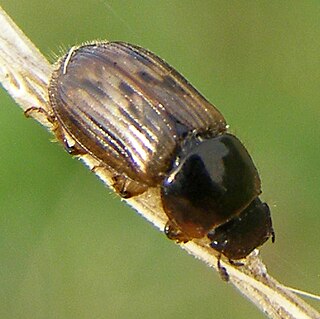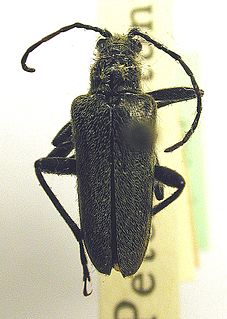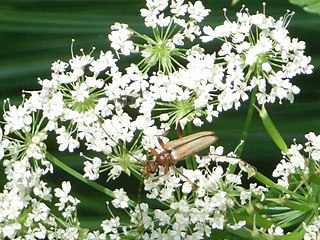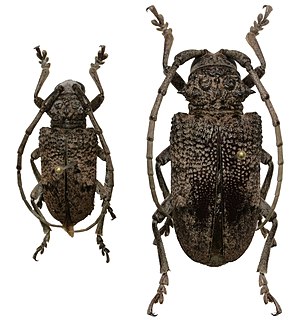
Johan Christian Fabricius was a Danish zoologist, specialising in "Insecta", which at that time included all arthropods: insects, arachnids, crustaceans and others. He was a student of Carl Linnaeus, and is considered one of the most important entomologists of the 18th century, having named nearly 10,000 species of animals, and established the basis for the modern insect classification.

Sphaerites is a genus of beetles, the only genus in the family Sphaeritidae, sometimes called the false clown beetles. It is closely related to the clown beetles but with distinct characteristics. There are five known species, widespread in temperate area but not commonly seen.

With over 500 species, Xyleborus is by far the largest ambrosia beetle genus in the tribe Xyleborini.

Aphodius is a genus of beetles in the family Scarabaeidae. In most species both the adults and larvae are coprophagous although some species have herbivorous or saprophagous larvae. Aphodius species typically dominate dung beetle communities in north temperate ecosystems. Most species are functionally classified as endocoprids, also known as dwellers, because the larvae live and feed within the dung pat itself.

Acmaeops smaragdula is a species of the Lepturinae subfamily in the long-horned beetle family. This beetle is distributed in Belarus, Finland, France, China, Italy, Latvia, Mongolia, Norway, Poland, Russia, Sweden, and Switzerland.

Acmaeops marginata is a species of the Lepturinae subfamily in the longhorn beetle family. It was described by Johan Christian Fabricius in 1781 and is known from Austria, Belarus, Belgium, Baltic states, Bosnia and Herzegovina, Croatia, Czech Republic, Finland, France, Germany, Greece, Italy, Norway, Poland, Russia, Serbia, Slovakia, Spain, Sweden, Switzerland, Ukraine, China, Mongolia, and Montenegro. Adult beetle feeds on Scots pine, and Norway spruce.

Rutpela maculata, the spotted longhorn, is a beetle species of flower longhorns of the family Cerambycidae, subfamily Lepturinae.

Dicerca is a genus of beetles in the family Buprestidae, containing the following species:

Macroplea mutica is a species of leaf beetles of the subfamily Donaciinae. It considered to be a Palearctic species, but can be found in Central Europe and Turkey.

Sternotomis pulchra is a species of beetle belonging to the family Cerambycidae.

Pidonia is a genus of beetles in the family Cerambycidae, containing the following species:

Coptops aedificator is a species of beetle in the family Cerambycidae. It was described by Johan Christian Fabricius in 1792, originally under the genus Lamia. It is known from Djibouti, Tanzania, the Democratic Republic of the Congo, Ethiopia, Oman, Gabon, India, Madagascar, Malawi, Namibia, Nigeria, Saudi Arabia, the Ivory Coast, Cameroon, Senegal, South Africa, Seychelles, Mauritius, Sri Lanka, and Zambia. It was also introduced into Cape Verde, Hawaii, and Taiwan. It feeds on Theobroma cacao and several Coffea species, including C. arabica, C. canephora, and C. liberica var. dewevrei.

The Fig-tree Borer Longhorn Beetle, or Fig Tree Borer, is a species of beetle in the family Cerambycidae. It was described by Johan Christian Fabricius in 1792, originally under the genus Lamia. It has a wide distribution throughout Africa. It feeds on Pyrus communis, Ficus carica, Salix babylonica, Cupressus sempervirens, and Vitis vinifera.
Nupserha bidentata is a species of beetle in the family Cerambycidae. It was described by Johan Christian Fabricius in 1792, originally under the genus Saperda.

Mycetophagus is a genus of hairy fungus beetles in the family Mycetophagidae. There are at least 20 described species in Mycetophagus.
Chalcosicya is a genus of leaf beetles in the subfamily Eumolpinae. It is mainly known from the West Indies, though one species is found in southern Mexico. It has recently been thought to be a sister genus to the Mediterranean Colaspidea, with Colaspina as a sister genus to the former two combined.
Costalimaita is a genus of leaf beetles in the subfamily Eumolpinae. The genus is distributed in South America. It was established by the Czech entomologist Jan Bechyné in 1954, and is dedicated to the Brazilian entomologist Ângelo Moreira da Costa Lima.
Upis is a genus of beetles, belonging to the family Tenebrionidae.














